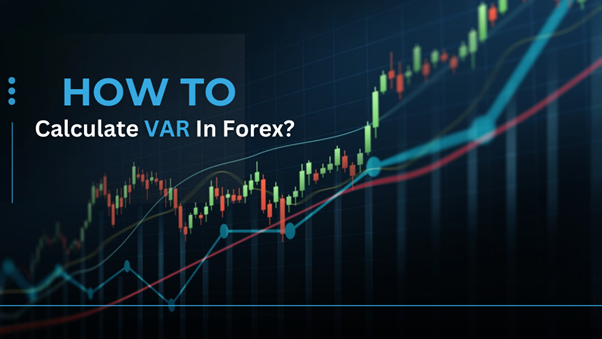How to Calculate VAR In Forex?
The first thing that you should know about before getting into forex trading is the possibility of losses. Forex currency pairs are one of the most liquid and volatile asset classes, making them popular trading instruments globally. But the volatile nature of currencies or, in other words, the frequent price fluctuations happening in the forex world also gives birth to many risks, and you are bound to encounter losses occasionally.
But you don’t have to be fearful of the risk as long as you learn to manage it well. The risks and rewards of trading go hand in hand, and earning profits won’t be possible unless you take calculated risks. This article will teach you some technicalities of market risk and will also introduce you to VAR, which is a tool for risk calculation in trading.
What is Value At Risk (VAR)?
VAR is the abbreviation for Value at Risk and is used to measure the exposure to market risk while trading. VAR can be closely associated with the calculation of profits and losses in a trade. Most forex traders calculate the potential of profits for their trades before placing an order, and the volatility and unpredictability of dynamic currency markets cannot be overlooked as the chances of losses are always there. Hence, we also need to prepare for the possible losses, which are calculated on the basis of the risk that we are taking for our trades. VAR is a way of assessing that risk which is essential for managing our trades in a way that we don’t lose much of our capital in the end.
So, we can say that VAR is a part of risk management in forex. It helps us to know the probability of losing a certain amount for trades kept open for a specified duration and the chances of the account balance dropping by a particular percentage within a short span of time. This is especially useful for traders who open multiple trade positions at a time and keep them running for a duration of a few days or longer. This helps you assess the possible scenario when any of these trade positions becomes a losing trade, which again tells you the best way to manage the situation when it happens.
You will also learn which of these positions need to be closed to stay true to your risk management policy and if you can open another trade for hedging or lowering the present risk. VAR can also be a tool for determining the optimal point for your Stop Loss levels for hitting your targets and keeping the overall account drawdown within limits. Also, one simple method to calculate Stop loss levels and other key metrics is by using automated trading calculators, which are freely available on trading platforms and forex broker platforms. Try using such simple tools as they save a lot of time and give you precise information needed for decision-making.
Simple VAR Calculation
The concept of VAR may look complex at first glance, but we will tell you it in a simplified manner so that you can easily comprehend this and apply it in your trades.
Scenario 1: One currency pair –
Imagine you are trading with EUR/USD only, and since the risk is a byproduct of volatility, we will have to take it into consideration for calculating the Value at Risk. Here, we will assume the volatility of this popular major pair to be around 0.5%. You are placing a spot trade of 1000 EUR/USD; the entry price is 1.10. On a typical day, you are anticipating the position’s value to fluctuate by 1.2 × 1000 x 0.5%, or $6 USD. The price can go up or drop as volatility only tells the extent to which the price will move and not the direction in which the movement will happen. So, over a duration of seven days, the average price shift possible is ±√7 × 6 USD
A 99% confidence interval is 2.33 standard deviations if each day’s fluctuations are consistently spread. As a result of using this, we get the following:
- 6 × 2.33 = $13.96 for 1 day VAR
- √7 × 6 × 2.33 = $36.93 for 7 day VAR
So, you can be 99% confident about not losing anything more than $13.96 in a day and $36.93 over the course of 7 days.
Scenario 2: Multiple Currency Pairs –
The calculation of VAR becomes a bit more complex when you trade with multiple currency pairs. Suppose you are trading with GBP/USD along with EUR/USD. You plan to go long on both pairs, with 1000 for the Euro pair and 2000 for the cable pair. You may be thinking of calculating the VAR of both pairs separately and adding them together to get the total VAR. But unfortunately, that won’t work as the strong positive correlation between these 2 pairs will become a problem. Both pairs have USD as the quote currency; hence, they will move together based on how USD gains or loses in value.
So, here we will consider the average correlation between these pairs, which is +70% over one week. As a consequence, we must compute the VAR of both positions with the condition that they are not detached from one another:
This yields the covariance VAR:
- √(36.29^2+13.96^2+2×36.29×13.96×0.7)= 47.12 USD
So, the VAR for one typical day is $47.12
- √(96.02^2+36.93^2+2×96.02×36.93×0.7)= 124.69 USD
And VAR for a duration of 7 days is $124.69
Hence there is a 99% probability of max loss being limited to $47.12 in a day, and for 7 days that would be $124.69. Note that GBP/USD gave only a minor risk reduction. The VARs would have been cumulative if the two positions were in perfect correlation with r=1. That indicates the VAR for 7 days will change from 124.69 to 96.02+36.93 = 132.95. The Value at Risk for one day will increase to 50.25 from 47.12. So, you can see that the second trade position lowered the relative risk by around 6% only via diversifying.
How to Reduce the Risk With VAR?
Now we know that trading two strongly correlated pairs does not help much in reducing the risk. So, let’s try another pair, AUD/USD, which has a lower correlation of +50% over a week with EUR/USD. The Aussie Dollar pair is priced at 1.01, and volatility is 0.6% for a day. So, again you go long on both pairs by buying 1000 Euro and 2000 AUD. After calculation, the Value at Risk turned out to be $37.19 for one day and $98.40 for 7 days. So, the Aussie Dollar pair provides more diversification and better lowers the risk than the cable pair.
Potential Account Loss Estimation and Applying VAR In Your Trades Var
For estimating the potential account loss, you should consider the total balance in your trading account. Suppose you have $500 trading capital before entering the trade and are trading with EUR/USD and GBP/USD, as mentioned above. To calculate the probability of losing 10% of your capital ($50) in 7 days, you can take the 7 day VAR calculated, which is $124.69. With a 1% probability, we do this calculation backwards and find that $50 for a 7-day VAR is 82%, based on which there is only an 18% chance of losing that much in the said duration.
Now, if you ask about applying VAR in your trades or using it for practising, then we suggest you go on your chosen platform, be it MT4 or MT5, and start trading. Then you will learn to apply Value at Risk in your day-to-day trades. But for beginners, we recommend starting off with demo account trading to avoid losing real money, and you can freely practise the concepts before going live.
Drawbacks of the VAR Method
The VAR tool is not 100% accurate, and you must know about its limitations to use it well.
- Volatility and correlation can change over time which is not considered in VAR.
- Unpredictable scenarios can happen, which invalidates VAR.
- The risk of changes in liquidity as well as counterparty risks, are not taken into consideration.
Wrap Up
We are wrapping up this write-up as we have covered all key points that a trader should know for calculating VAR in forex and also mentioned the best ways for applying the same for risk management. VAR is a powerful tool for safeguarding your capital by limiting losses if you use it properly. So, take your time to learn for a level up.

















